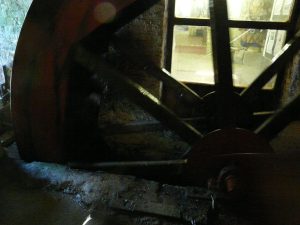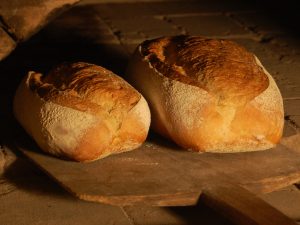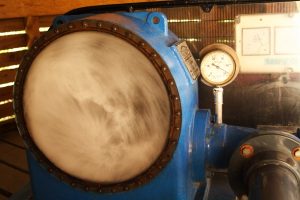When building works were completed on the Queen’s Mill in 1888, it became the world’s largest water powered stone grinding flour mill. The water wheel was a 20 foot diameter piece of iron and timber Victorian engineering, large for its type and with high efficiency features. It turned twenty mill stones using water from the River Aire in Castleford, West Yorkshire. The wheel was so efficient in fact that it remained operating until the early 1970s, when the sluice gate was closed, and the mill stones switched to grid electric power. Since then, the wheel has remained in-situ covered within its brick housing.

John Smeaton
Castleford is a former Roman settlement. The “ford” across the Aire adjacent to where was once a roman fort [Ceaster Forda – “ford by the Roman fort”] is 100 metres from the Queen’s Mill. It became a boom town during the 1800s with the establishment of numerous heavy industries such as coal mining and coke gasification, pottery, chemical, textile, glassware and brick manufacture. As with many northern British communities, with these industries gone, adult unemployment increased, and social cohesion suffers. Part of Castleford is in the top 5% of most deprived wards in England, and over 45% of 0-16 year olds in Castleford are living in families claiming means tested benefits.

Central hubs from Queen’s Mill water wheel
The Queen’s Mill lasted longer than most of these industries, with operation stopping in 2011. In 2013 it was bought by Castleford Heritage Trust, a charity whose aim is to benefit the community by preserving local industrial and archaeological wealth along with natural resources such as waterways, local woodlands and other green spaces. The plan is to open the Queen’s Mill as a community venue and museum with each of the mill stones assigned to a former industry, bringing back Roman artefacts and art collections (Henry Moore the sculptor was born in Castleford), and restoring the water wheel to generate hydro-electricity.

Clough gearing (sluice control)
The history of water wheels is an interesting one. They can be traced back to antiquity, and reached their peak in Britain in the mid to late 1700s, prior to the age of steam. Information on the science of water wheel engineering is difficult to obtain in 2015, and is something of a lost craft. The most famous water wheel engineer of his time was John Smeaton (1724-1792) who coincidentally was born just 6 miles from Castleford. Smeaton discovered that gravity wheels (where water enters in line with or above the axial plane – “overshot” or “breastshot” types) were more efficient than impulse wheels (where the wheel is turned by the momentum of natural water flow velocity – most “undershot” types). A few decades later, in the early 1800s two French engineers Borda and Carnot determined that highest efficiencies will be achieved if water “enters without impact and leaves without energy” – thus transferring all energy to the turning force of the wheel.

Sole plate
It is unlikely that Smeaton was involved in earlier designs of the Queen’s Mill due to his international prominence as the world’s first “civil engineer”. But, the Queen’s Mill water wheel was designed with all these high efficiency features. It is a breastshot gravity wheel (Smeaton was singularly responsible for the replacement of impulse undershot wheels with gravity breast wheels in the late 18th Century) with curved buckets so that the water does not lose any energy as it enters. The iron rims at the side (the wheel “sheaths”) stop water losses from the sides (Nb, a wheel without these sheaths has “paddles” rather than “buckets”). The “breast” in a breastshot wheel is the stone which follows the circumference of the wheel in the lower near side (water entry) quarter. The closeness of this breast – usually made of the highest quality stone – also stops water losses. The breast shot wheel is positioned out of the water to avoid the resistance from water leaving – which can result in the wheel being known as “tail bound”. The Queen’s Mill wheel has also the largest possible “wetted width” (the volumetric capacity of each bucket), having only a few centimetre clearance on each side of the wheel housing and by having the outer spokes retainers on the inside.

Queen’s Mill from Castleford Bridge
With grant funding from the Wakeham Trust and The Royal Commission for the Exhibition of 1851, assistance from a local building college, Owe Arup, and volunteers, the wheel is being preserved from decay, documented and restored to heritage standards. This is for the community and so presentations are given throughout the year at Queen’s Mill open days where the public can find out more about the building, Victorian water wheel science and engineering, how it is being restored, and at 24 tonnes how it was installed! Alternatively, private tours and visiting presentations can be arranged (please use the contact links below). The Queen’s Mill is also open to the general public and operates a community café. Milling is soon to start using local organic wheat in honour of one of its former owners, Dr Thomas Allinson (1858-1918), who believed that natural foods were better for health than taking medicines, and for this belief he was struck off the medical register.
By Dr Andrew N. Rollinson, Blushful Earth





2 Comments
Fascinating stuff. Is that the same Allinson as the bread company?
Yes it is.